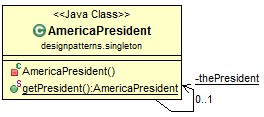Singleton pattern is one of the most commonly used patterns in Java. It is used to control the number of objects created by preventing external instantiation and modification. This concept can be generalized to systems that operate more efficiently when only one object exists, or that restrict the instantiation to a certain number of objects, such as:
- private constructor – no other class can instantiate a new object.
- private reference – no external modification.
- public static method is the only place that can get an object.
The Story for Singleton
Here is a simple usage case. A country can have only one president (maybe normally). So whenever we want a president, just use AmericaPresident to return one. getPresident() method will make sure there is always only one president created. Otherwise, it would not be so nice.
Class Diagram
package com.programcreek.designpatterns.singleton;
public class AmericaPresident {
private AmericaPresident() { }
private static AmericaPresident thePresident;
public static AmericaPresident getPresident(){
if(thePresident == null)
thePresident = new AmericaPresident();
return thePresident;
}
} java.lang.Runtime#getRuntime()
getRunTime() returns the runtime object associated with the current Java application.
Process p = Runtime.getRuntime().exec(
"C:/windows/system32/ping.exe programcreek.com");
//get process input stream and put it to buffered reader
BufferedReader input = new BufferedReader(new InputStreamReader(
p.getInputStream()));
String line;
while ((line = input.readLine()) != null) {
System.out.println(line);
}
input.close();Pinging programcreek.com [198.71.49.96] with 32 bytes of data:
Reply from 198.71.49.96: bytes=32 time=53ms TTL=47
Reply from 198.71.49.96: bytes=32 time=53ms TTL=47
Reply from 198.71.49.96: bytes=32 time=52ms TTL=47
Reply from 198.71.49.96: bytes=32 time=53ms TTL=47
Ping statistics for 198.71.49.96:
Packets: Sent = 4, Received = 4, Lost = 0 (0% loss),
Approximate round trip times in milli-seconds:
Minimum = 52ms, Maximum = 53ms, Average = 52ms





















 585
585











 被折叠的 条评论
为什么被折叠?
被折叠的 条评论
为什么被折叠?








